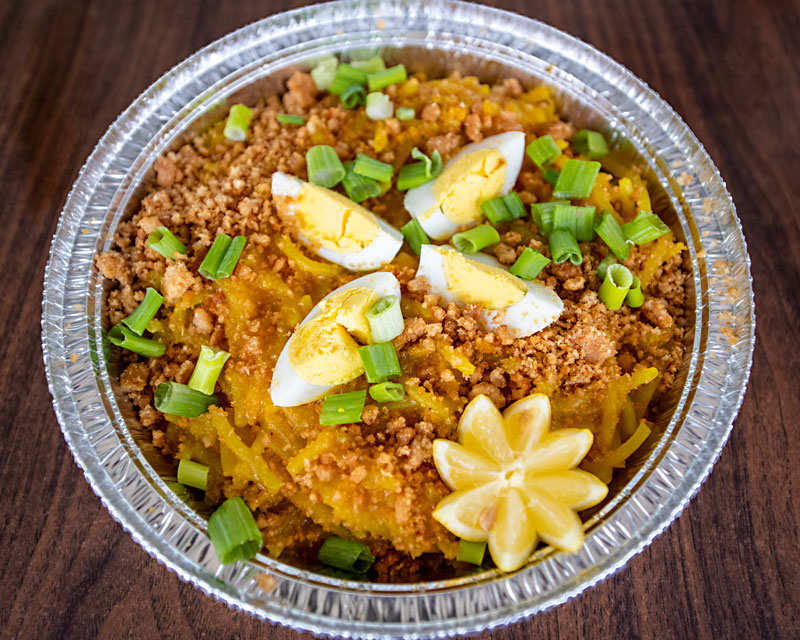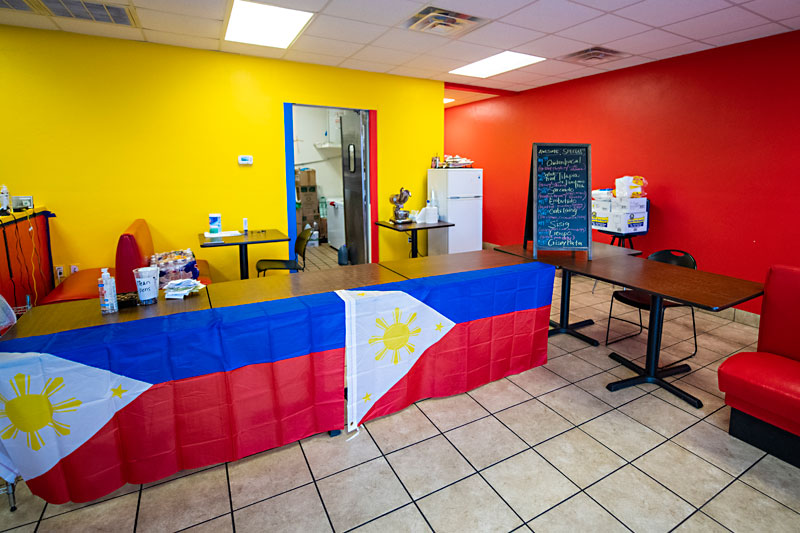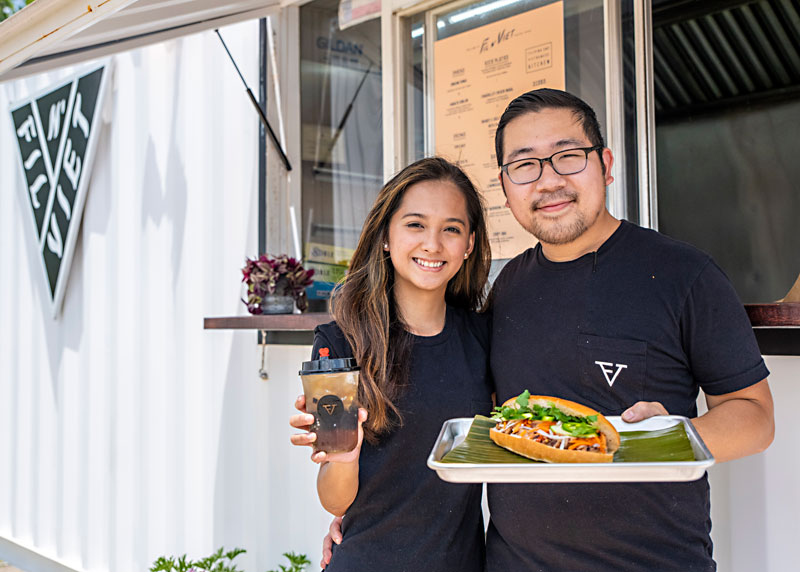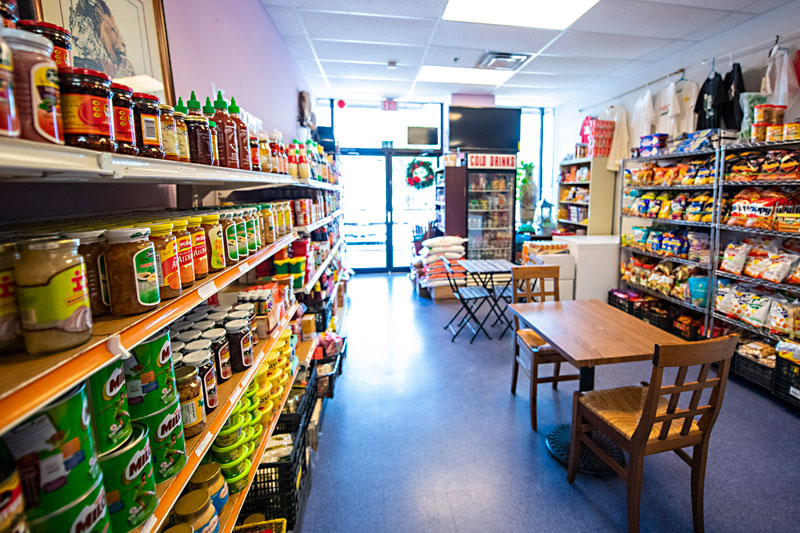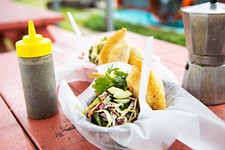Five Fantastic Options for Filipino Cuisine in Austin
Finding family via bold and delicious feasts
By Adam Wood, Fri., June 25, 2021
For the heart of Austin's culinary culture to survive, we must not just remember but cherish the treasures, hidden in plain sight, that have built our city into the culinary mecca whose reputation we flaunt as eagerly as we forget it. One substratum of the community that stands at a particularly treacherous crossroads is Filipino cuisine.
The past two years have seen three staples of Austin's sparse Filipino offerings (Tito Adobo, Mang Dedoy's, and Be More Pacific, which reopened in Houston) shutter their doors, encumbered not only by pandemic pressures but also widespread hesitancy to step outside the collective comfort zone. Not that Filipino food is particularly foreign, mind you. At heart, it is a culinary collision between Asian and Spanish flavors, and that should play to these restaurants' favor. Sitting at the sweet spot between familiarity and exoticism and boasting all sorts of intoxicating flavors and psychedelic colors, Filipino food has every reason to be accepted and adored. For whatever reason, though, cuisine from the Philippines remains underrepresented and underappreciated in mainstream America. Maybe it boils down to an admirable refusal to sacrifice traditional flavor and cultural identity for quick success.
The most popular Filipino dishes are actually straightforward and accessible. Pancit is a light, vermicelli-esque rice noodle dish with limitless variants. Adobo is an ancient and timeless classic featuring succulent pork belly braised in a rich marinade of soy sauce and vinegar. Lumpia are dainty fried egg rolls delicately wrapped in rice paper and stuffed with shredded vegetables, minced meats, and savory seasonings. Lechon kawali satisfies with deep-fried slabs of pork belly that boast the extravagantly greasy crunch of chicharróns while never losing that innate, intimate tenderness that makes it such a delicacy.
What some less-familiar Filipino fare lacks in immediate approachability, it makes up for in pure intrigue (and excellence). The legendary summertime dessert halo-halo is a fantastical fusion of flavors, towering with vibrant layers of shaved ice, fluorescent pandan jellies, sweet beans, jackfruit, evaporated milk, sweetened condensed milk, ube (purple yam) ice cream, flan, and/or really whatever else you want to add in. It is exactly as deliciously strange as it sounds.
Each of these restaurants promise outstanding versions of some or all of these dishes, plus others sure to delight customers to their core. More importantly, however, they are run by families, couples, and individuals who believe in using their food to share themselves and their culture with the wider world, perhaps changing it in the process.
Little Mama’s Authentic Filipino Cuisine
2021 N. Mays #1000, Round Rock; fb.com/littlemamas512"Family and food go hand in hand," says Joanna Meyer, co-owner of Little Mama's Authentic Filipino Cuisine. The expression is wonderfully literal – the Filipino style of eating straight from the table with banana leaves as plates and only fingers as utensils is termed "kamayan," after the Tagalog word for "hands." This communal eating encourages flavors and feasters alike to socialize. In Filipino culture, sharing a meal "family-style" is an act of hospitality and a profound expression of love. It's also an indirect act of anti-imperialism and ancestral reclamation: After the 1898 Treaty of Paris put the Philippines under United States control, the kamayan style of eating (or "boodle fight") became taboo.
Though barehanded buffets still seem unwise for a little while yet, Little Mama's is propelling their culture's beautiful philosophy into a post-pandemic world. The restaurant, which celebrated its six-year anniversary in January, is owned and operated by founder Nita and her three children. Opening a restaurant was never in the plan, but as Nita grew increasingly frustrated by the lack of appreciation for Filipino cuisine, she took it upon herself, with the help of her built-in team, to create something that would celebrate their history, lineage, culture, and the notion of family itself. To hear it from Meyer, "The more the merrier," which may as well be Little Mama's motto.
Little Mama's offers standard Filipino dishes like adobo, pancit, lumpia, and lechon kawali. "No matter where you're from in the Philippines, these are staples at every gathering," Meyer says. "But with the Philippines being so large and composed of so many different islands, each with such a unique background of flavors and cultural influences from China and the Spaniards, everyone has a different style and flavor profile depending on what region they are from. Our mom is from the Bicol region, so she specializes in spicy peppers and coconut milk."
The Bicol region, on the northeast brim of the 7,640-island Philippine archipelago, is an adventurer's paradise full of secret white-sand beaches, active volcanoes (including the perplexingly symmetrical Mount Mayon, which has erupted five times since the turn of the century), and legendarily lazy local butanding (whale sharks). To explore there is to expand your limits, to push yourself to new frontiers.
That intrepid spirit is imbued in the soul of the islands, their inhabitants, and, in turn, their cuisine. Bicolano dishes strike with a passionate heat, blessed with a capsaicin kick due to the regionally unique Latin American influence after mid-14th century colonizers brought chile peppers. There's the siling labuyo, a pungent, now-native bright-red pepper at a flaming 100,000 Scoville heat units; and siling haba, a green dagger of much milder heat. The former is used for the legendary Bicol Express (gulay na lada), a face-meltingly spicy stew named after the passenger train that runs between Manila and Legazpi. Though variations are wide and welcomed, the classic dish (a point of Little Mama's pride) sees simmered chunks of pork combine with coconut cream (katang gata), garlic, onion, ginger, and shrimp paste (bagoong alamang) before chefs turn the heat up with a generous dose of siling labuyo.
Less adventurous eaters might be more inclined to ease into the hot seat with a serving of gabi laing (aka pinangat na gabi), which replaces chile peppers with whole taro leaves to create a base with more balance and a less vicious bite. Like the Bicol Express, and most dishes from a region flourishing with over 50 million coconut trees, gabi laing relies heavily on the soothing qualities of katang gata to counteract the chile's venom.
Elsie’s Egg Rolls Filipino Kitchen
525 Chris Kelley Blvd. Ste. 100-A, Hutto; www.elsieseggrolls.comA kind woman with a generous heart, Elsie Corass, chef/owner of Hutto's eponymous Elsie's Egg Rolls Filipino Kitchen, embarked in 2014 on a quest to bring lumpia and Filipino flavors to the town that she has adopted and made her own.
That journey has not always been easy. Despite lifelong skirmishes with discrimination and a childhood spent aware of the pressures of poverty in the Laguna province, Corass has spent decades devoted to using her food and everything it represents to better the lives of everyone around her. She says, "My mission is to share a piece of Filipino culture with my small community here in Texas by means of the food I cook, and to truly show that we should not judge a book by its cover."
Each lumpia Corass serves is a creation of care, hand-rolled with delicate affection so that it contains not just delicious flavors but memories, stories, laughter, and love. Corass says, "Food is a huge part of my family's story, but lumpia is the most special because I consider it to be an inheritance from my grandmother. She used to have a small business in our community from the 1950s until the 1970s, where she would cook hundreds of lumpia in the morning, seven days a week. My mom and my aunts were the rollers. My grandmother's brother would make the wrapper. There were about 10 women who would go into different towns on foot to sell these lumpia on a consignment basis, and then they would come back at the end of the day to pay my grandmother whatever was sold for 10 centavos per lumpia." (For reference, 10 Philippine centavos equal about two-tenths of a U.S. cent.)
After her grandmother aged and had to shutter the business the family struggled to make ends meet, and Corass, with entrepreneurial spirit in her veins, pursued the passion and purpose she inherited from a grandmother whose warm presence filled the kitchen every time Corass fired up the oven. "At the age of 9, I started to cook on weekends and would sell to the neighborhood. Watching my mom cook helped me a lot, and I started to dream of becoming a businesswoman and having my own restaurant someday."
In 2020, Corass braved the fickle volatility of a pandemic-stricken world to open up her own brick-and-mortar after six years spent dispensing lightly fried joy out of a food truck. Though lumpia has a special place in Corass' heart, the restaurant offers a fabulous array of Filipino fare, including the ubiquitous pancit, adobo, and a Filipino-style chicken curry. She also serves a weekend breakfast menu featuring tokwa't baboy (tofu with pork belly), lugaw (savory rice porridge) and silog (garlic fried rice thickened with sunny-side up yolk and your choice of protein – we recommend the tocino, a slightly sweet, caramelized pork belly bacon).
As Corass and her crew settle into their permanent location, they hope to share their Filipino culture and flavors with their community through an expanded menu. Corass is particularly excited to introduce Hipon ni Nanay Eda, a shrimp and coconut milk concoction that is an original recipe from her late mother, Imelda (aka Eda), and has garnered rave reviews from the few nonfamily members lucky enough to taste it. Keep your fingers crossed also for the addition of her ultimate comfort food sinigang na baboy, in which crisp vegetables and tender morsels of pork harmonize while a sour tamarind broth sings the melody of Corass' childhood.
Carabao Express
2309 W. Parmer; carabaoexpress.comWith its charming mascot and expansive menu, Carabao Express streamlines the magic of Filipino cuisine into a modern, convenient, and straight-up cute package – without sacrificing quality or authenticity. Owners Nick and Colleen Saunders have taken it upon themselves to demystify Filipino cuisine, providing photos and descriptions of each dish both online and in person. Though you could order a bowl or a box, with one or two bases and entrées, respectively, the smart move (the only move) is to order the Boodle Box, which promises "your very own Boodle Fight in a box," complete with two bases, three entrées, lumpia Shanghai, veggie lumpia, pickled red onions, cucumbers, tomatoes, green onions, sliced jalapeños, and sauces. Protein options run the Philippine gambit: chicken adobo, lechon kawali, lechon crispy sisig (spicy chopped pork belly), longanisa (sweet, garlicky sausage patties), pork tocino, beef tapa, and pancit palabok. Carabao Express has also explored some ambitiously playful culinary fusions, including mouthwatering pork belly sisig birria tacos. Those lusting for some scandalous sweets are in for a treat, and can pick their poison between banana turon (which use the lumpia's deep-fried rice wrappers to smuggle in piping hot plantains) and pineapple Dole Whip, which we would humbly recommend ordering in float form.
Fil N’ Viet
1720 E. 12th; filnviet.comBrand-spanking-new food truck Fil N' Viet and its rock star chef Kevin Truong were just nominated by CultureMap Austin for Best New Restaurant and Rising Star Chef of the Year, respectively, for their revolutionary marriage of Filipino and Vietnamese cuisines. A creation of love, born from love, Fil N' Viet is owned and operated by Kevin and his wife, Rosie Mina-Truong, who turned to her mother's recipes and the ancestral magic of cooking to combat homesickness and stay grounded in her Philippine roots. Food facilitated the early days of the couple's budding romance; food was the medium through which they could share their histories, their heritages, their stories, and, eventually, their lives. They were delighted to discover that the chemistry resonating between them, one deeply rooted in a shared consecration of family and an affinity for cooking, was paralleled by a natural compatibility between their native food traditions and cuisines.
The result is an imaginative menu that celebrates and accentuates Filipino and Vietnamese cuisine equally. Their bánh mì protein selections include a wild mushroom tofu adobo – made with special Silver Swan soy sauce that is famous for imbuing Filipino food with just the "tamang timpla" (right blend) of umami flavor – and crispy sisig, a classic pork dish they brighten up with calamansi, a native sour citrus with a sweet peel, like an inverted kumquat. Fil N' Viet also offers rice plates with your choice of chicken inasal (barbecue chicken marinated in vinegar, calamansi, and lemongrass) or braised beef ribs with chả trứng, a Vietnamese egg meatloaf. Lighter fare includes sinigang wings, made with the tamarind used for the sour traditional soup, as well as hamachi kinilaw, an exquisite Filipino-style citrus ceviche whose sour bite is mellowed out with coconut milk. Add a whimsical flare to your meal with a Vietnamese iced coffee infused with ube, turning the drink a deep purple hue that gradually diffuses to a gentle lavender.
Filipino Asian Mart
615 W. Slaughter #110; filipino-asianmart.comThose feeling culinarily inspired by these bold flavors and bright colors may consider checking out Filipino Asian Mart, a combination specialty grocery store and restaurant serving quick, to-go Filipino food. With elusive items just an aisle away, Filipino Asian Mart is equipped to offer an extravagant menu of all the Philippines' finest fare. Bolster your entrée of choice (they have a lot to choose from) with some striking ube cheese pandesal (vivid violet, cheese-filled bread rolls), and top it off with any number of their specialty dessert options, including halo-halo; biko, a syrupy, sticky kakanin (rice cake) with brown sugar and coconut milk; leche flan (denser than its Mexican counterpart); and sapin-sapin (a playful layered variation of glutinous rice kakanin).





